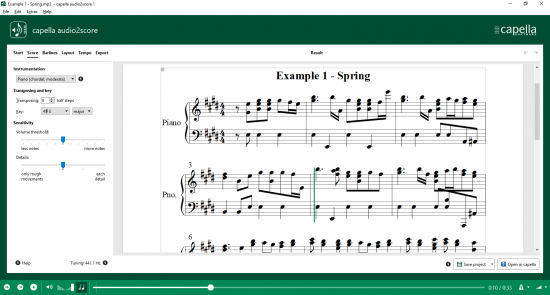
File Size: 372 MB
capella audio2score 分析您的录音,例如 MP3 文件。 识别出的音符经过检查、分类,然后合理地融入新的安排中。 例如,这可以为钢琴或四重奏完成 – 这是您的选择。
capella audio2score pro 不会向您显示原始内容的准确转录。 请想象结果更像是钢琴还原或粒子细胞(取决于您的设置)。 导出为 Midi、无伴奏合唱或 MusicXML 格式以及 PDF。
功能列表
逐个音符识别
AI辅助笔记识别
三种音色的区别:1.管乐,2.弦乐,3.钢琴
优化钢琴独奏模式
识别可以与歌声识别相结合
适用于没有人声的作品(可以对人声进行立体声抑制并单独识别伴奏,具体取决于录音)
识别任何乐器录音(打击乐除外)的复调声音
自动排列识别出的各种合奏的音符(可选:钢琴、弦乐四重奏、管乐五重奏、吉他、单声道等); 独立于原作
智能分配音符到声音(没有固定分割点,而是形成线条)
钢琴编曲不同难度级别的规范; 细节级别滑块
和谐检测
和谐符号
整体认可
适合无人声或有人声的作品
旋律识别(器乐和/或声乐;有区分)
低音线检测
基于和声的伴音实现
可选择预定义合奏(钢琴、管弦乐队、乐队……)
即使是复杂的作品也能获得稳健、可玩的结果
进一步认可
小节线的识别(如果需要可以纠正)
按键检测(如果需要可以纠正)
调音检测(音乐会音高a’)
根据和声背景自动局部推导等音变化(“F 升”或“G 降”?)
自由配置:使用单独的声音、识别设置、量化和伴奏模式设置任何所需的合奏
逐条识别与整体识别相结合; 为新项目创建模板
如果需要,可以调换注释
支持移调乐器
编辑
来自声音组织的支持,提供对声音的视觉洞察
将音调显示为音调框(钢琴卷帘视图)和音符图像
两个视图直观编辑,实时同步
和声的后处理(伴奏声音适应)
小节线和节拍笔划:可通过手动设置标记进行更改
小节线:通过在播放时点击来更改
部分笔记格式可调整(页面大小、小节编号……)
用于所有声部的乐谱布局的声部编辑器(谱号、行距、小节线等)
手术
所有设置均具有实时视觉和听觉预览
通过 soundfont (capella-tune) 定性播放已识别的音符
通过以任何速度(时间拉伸)同时播放原件(混音器功能)来控制结果的收听
鼠标模式:任意速度的鼠标滑动播放和/或识别
音调盒和播放的语音过滤
现代 MDI 界面,可以并排放置多个文档/视图
易于使用、有限的入门向导界面
可以随时切换到主程序(完整功能)并返回
将音符直接传输到无伴奏合唱
程序中的帮助说明和详细文档
capella audio2score analyzes your recording, e.g. an MP3 file. The recognized notes are examined, sorted and then sensibly poured into a new arrangement. This can be done for piano or for a quartet, for example – it’s your choice.
capella audio2score pro does not show you an exact transcript of the original. Please imagine the result more like a piano reduction or a particell (depending on your settings). Export to Midi, capella or MusicXML format as well as PDF.
Feature list
Note by note recognition
AI-assisted note recognition
Distinction of three timbres: 1. winds, 2. strings, 3. piano
Optimized mode for solo piano
Recognition can be combined with the recognition of a singing voice
Suitable for pieces without vocals (stereo suppression of vocals and sole recognition of accompaniment possible, depending on recording)
Recognition of polyphonic sounds of any instrumental recordings (except percussion)
Automatic arrangement of the recognized notes for various ensembles (selectable: piano, string quartet, wind quintet, guitar, monophonic, etc.); independent of the original
Intelligent distribution of notes to voices (no fixed split points, but formation of lines)
Specification of different levels of difficulty for piano arrangements; Level of detail slider
Harmony detection
Harmony symbols
Holistic recognition
Suitable for pieces without or with vocals
Recognition of the melody (instrumental and/or vocal; with differentiation)
Bass line detection
Realization of accompanying voices based on the harmonies
Predefined ensembles selectable (piano, orchestra, band, …)
Robust, well playable result even with complex pieces
Further recognition
Recognition of barlines (can be corrected if desired)
Key detection (can be corrected if desired)
Tuning detection (concert pitch a’)
Automatic local derivation of enharmonic changes (“F sharp” or “G flat”?) according to the harmonic context
Free configurability: set up any desired ensembles with individual voices, recognition settings, quantization and accompaniment patterns
Combination of note-by-note and holistic recognition; creation of templates for new projects
Notes can be transposed if desired
Support of transposing instruments
Editing
Support from the sound tissue, which provides visual insight into the sound
Display of tones as tone boxes (piano roll view) and as note images
Intuitive editing in both views, real-time synchronization
Post-processing of harmonies (accompanying voices adapt)
Barlines and beat strokes: changeable by manually setting marks
Barlines: changeable by tapping along with playback
Adjustable formatting of the notes (page size, bar numbers, …) partly
Voice editor for the score layout of all voices (clefs, line spacing, solid barlines, etc.)
Operation
All settings with visual and acoustic preview in real time
Qualitative playback of recognized notes via soundfont (capella-tune)
Control listening of the result by simultaneous playback of the original (mixer function), at any tempo (time stretching)
Mouse mode: playback of original and/or recognition by mouse swipe at any tempo
Voice filtering for tones boxes and playback
Modern MDI interface in which multiple documents / views can be placed side by side
Easy-to-use, limited wizard interface for getting started
Switch to the main program (complete features) and back possible at any time
Direct transfer of the notes to capella
Help notes in the program and detailed documentation
Homepage
https://anonymz.com/…la-software.com
